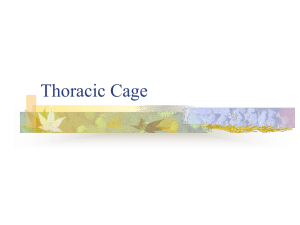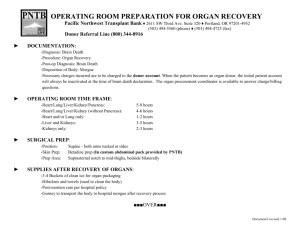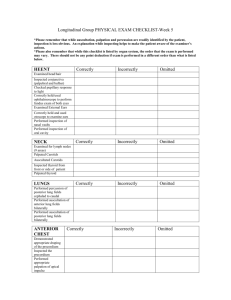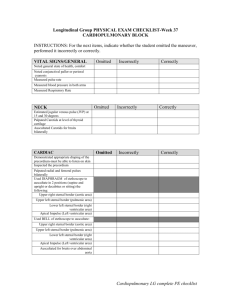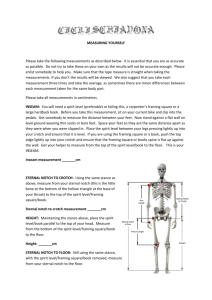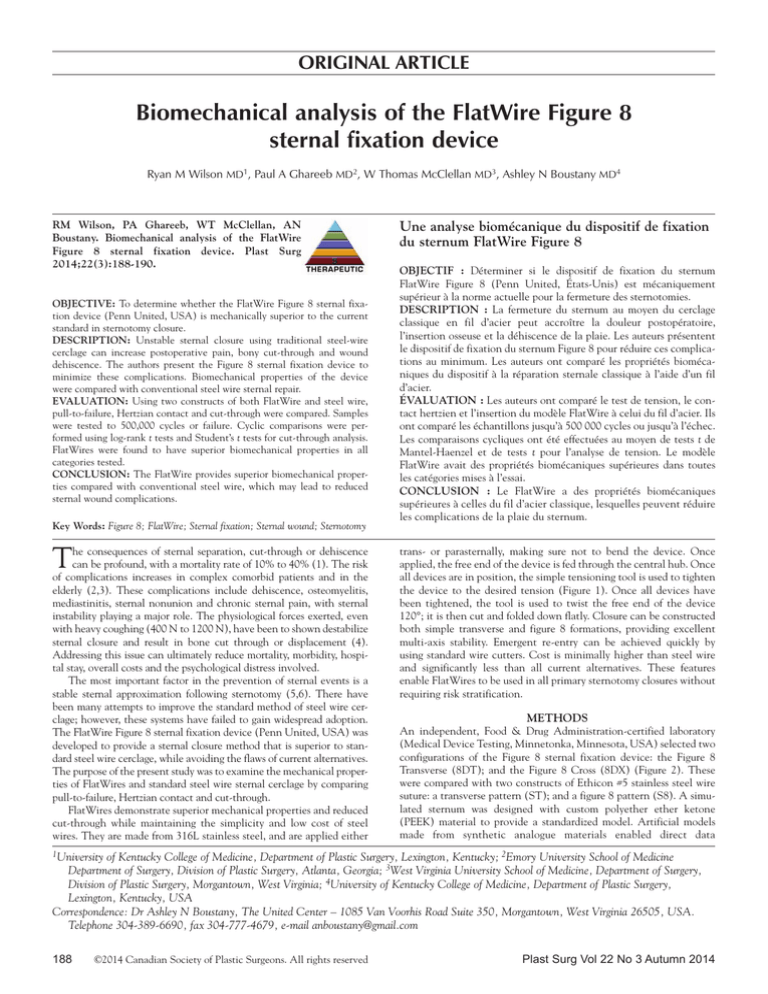
original article
Biomechanical analysis of the FlatWire Figure 8
sternal fixation device
Ryan M Wilson MD1, Paul A Ghareeb MD2, W Thomas McClellan MD3, Ashley N Boustany MD4
RM Wilson, PA Ghareeb, WT McClellan, AN
Boustany. Biomechanical analysis of the FlatWire
Figure 8 sternal fixation device. Plast Surg
2014;22(3):188-190.
objective: To determine whether the FlatWire Figure 8 sternal fixation device (Penn United, USA) is mechanically superior to the current
standard in sternotomy closure.
Description: Unstable sternal closure using traditional steel-wire
cerclage can increase postoperative pain, bony cut-through and wound
dehiscence. The authors present the Figure 8 sternal fixation device to
minimize these complications. Biomechanical properties of the device
were compared with conventional steel wire sternal repair.
Evaluation: Using two constructs of both FlatWire and steel wire,
pull-to-failure, Hertzian contact and cut-through were compared. Samples
were tested to 500,000 cycles or failure. Cyclic comparisons were performed using log-rank t tests and Student’s t tests for cut-through analysis.
FlatWires were found to have superior biomechanical properties in all
categories tested.
Conclusion: The FlatWire provides superior biomechanical properties compared with conventional steel wire, which may lead to reduced
sternal wound complications.
Key Words: Figure 8; FlatWire; Sternal fixation; Sternal wound; Sternotomy
T
he consequences of sternal separation, cut-through or dehiscence
can be profound, with a mortality rate of 10% to 40% (1). The risk
of complications increases in complex comorbid patients and in the
elderly (2,3). These complications include dehiscence, osteomyelitis,
mediastinitis, sternal nonunion and chronic sternal pain, with sternal
instability playing a major role. The physiological forces exerted, even
with heavy coughing (400 N to 1200 N), have been to shown destabilize
sternal closure and result in bone cut through or displacement (4).
Addressing this issue can ultimately reduce mortality, morbidity, hospital stay, overall costs and the psychological distress involved.
The most important factor in the prevention of sternal events is a
stable sternal approximation following sternotomy (5,6). There have
been many attempts to improve the standard method of steel wire cerclage; however, these systems have failed to gain widespread adoption.
The FlatWire Figure 8 sternal fixation device (Penn United, USA) was
developed to provide a sternal closure method that is superior to standard steel wire cerclage, while avoiding the flaws of current alternatives.
The purpose of the present study was to examine the mechanical properties of FlatWires and standard steel wire sternal cerclage by comparing
pull-to-failure, Hertzian contact and cut-through.
FlatWires demonstrate superior mechanical properties and reduced
cut-through while maintaining the simplicity and low cost of steel
wires. They are made from 316L stainless steel, and are applied either
Une analyse biomécanique du dispositif de fixation
du sternum FlatWire Figure 8
OBJECTIF : Déterminer si le dispositif de fixation du sternum
FlatWire Figure 8 (Penn United, États-Unis) est mécaniquement
supérieur à la norme actuelle pour la fermeture des sternotomies.
DESCRIPTION : La fermeture du sternum au moyen du cerclage
classique en fil d’acier peut accroître la douleur postopératoire,
l’insertion osseuse et la déhiscence de la plaie. Les auteurs présentent
le dispositif de fixation du sternum Figure 8 pour réduire ces complications au minimum. Les auteurs ont comparé les propriétés biomécaniques du dispositif à la réparation sternale classique à l’aide d’un fil
d’acier.
ÉVALUATION : Les auteurs ont comparé le test de tension, le contact hertzien et l’insertion du modèle FlatWire à celui du fil d’acier. Ils
ont comparé les échantillons jusqu’à 500 000 cycles ou jusqu’à l’échec.
Les comparaisons cycliques ont été effectuées au moyen de tests t de
Mantel-Haenzel et de tests t pour l’analyse de tension. Le modèle
FlatWire avait des propriétés biomécaniques supérieures dans toutes
les catégories mises à l’essai.
CONCLUSION : Le FlatWire a des propriétés biomécaniques
supérieures à celles du fil d’acier classique, lesquelles peuvent réduire
les complications de la plaie du sternum.
trans- or parasternally, making sure not to bend the device. Once
applied, the free end of the device is fed through the central hub. Once
all devices are in position, the simple tensioning tool is used to tighten
the device to the desired tension (Figure 1). Once all devices have
been tightened, the tool is used to twist the free end of the device
120°; it is then cut and folded down flatly. Closure can be constructed
both simple transverse and figure 8 formations, providing excellent
multi-axis stability. Emergent re-entry can be achieved quickly by
using standard wire cutters. Cost is minimally higher than steel wire
and significantly less than all current alternatives. These features
enable FlatWires to be used in all primary sternotomy closures without
requiring risk stratification.
METHODS
An independent, Food & Drug Administration-certified laboratory
(Medical Device Testing, Minnetonka, Minnesota, USA) selected two
configurations of the Figure 8 sternal fixation device: the Figure 8
Transverse (8DT); and the Figure 8 Cross (8DX) (Figure 2). These
were compared with two constructs of Ethicon #5 stainless steel wire
suture: a transverse pattern (ST); and a figure 8 pattern (S8). A simulated sternum was designed with custom polyether ether ketone
(PEEK) material to provide a standardized model. Artificial models
made from synthetic analogue materials enabled direct data
1University
of Kentucky College of Medicine, Department of Plastic Surgery, Lexington, Kentucky; 2Emory University School of Medicine
Department of Surgery, Division of Plastic Surgery, Atlanta, Georgia; 3West Virginia University School of Medicine, Department of Surgery,
Division of Plastic Surgery, Morgantown, West Virginia; 4University of Kentucky College of Medicine, Department of Plastic Surgery,
Lexington, Kentucky, USA
Correspondence: Dr Ashley N Boustany, The United Center – 1085 Van Voorhis Road Suite 350, Morgantown, West Virginia 26505, USA.
Telephone 304-389-6690, fax 304-777-4679, e-mail anboustany@gmail.com
188
©2014 Canadian Society of Plastic Surgeons. All rights reserved
Plast Surg Vol 22 No 3 Autumn 2014
Figure 8 sternal fixation device
Figure 1) FlatWire Figure 8 (Penn United, USA) tensioning device. The
Figure 8 device is placed in the tool, and the applicator is ratcheted using one
hand until the desired tension is achieved
comparisons between groups and are more available and affordable
than cadaveric sterna. Twenty-four PEEK sterna were divided into four
groups of six. The figure 8 engineer placed the Figure 8 devices, while
a board-certified cardiothoracic surgeon placed the Ethicon steel
wires. Two fixtures from each of the four groups were then selected for
ultimate tensile testing.
Fixtures were mounted to a servopneumatic cylinder (ELF 3230
EnduraTec, USA) for longitudinal shear testing. A longitudinal distraction force was cycled between −100 N and 100 N at 2 Hz to 10 Hz
for 500,000 cycles or until failure occurred. Failure was defined as
breakage or displacement of 4 mm from zero load. Ultimate tensile
strength was determined using a servopneumatic cylinder (series 3040
EnduraTec, USA) with pull-to-failure testing at a rate of 0.0038 mm/s.
Cut-through was tested using artificial sterna molded from 20 lb/ft3
rigid polyurethane foam (1025-2, Pacific Research Laboratories Inc,
USA) at a Food & Drug Aministration-approved facility (Peridot,
Pleasanton, California, USA). The models were hemisected longitudinally and secured to a base by simulated rib buds. Lateral distraction was applied with four forces separately along the sternal edge at
intervals: 30 lbs, 40 lbs, 50 lbs and 60 lbs. Force was applied with a
digital force gauge (Imada Z2, USA) at 2mm/s distraction until the
desired force was obtained and then held for 10 s. A Mitutoyo Vision
System (Quick Vision Elf, USA) (resolution 0.1 μm) measured depth
of penetration.
Statistical analyses were performed using SAS version 9.2 (SAS
Institute, USA); a log-rank test was used for cyclic comparisons and a
Student’s t test for the cut-through analysis; P<0.05 was considered to
be statistically significant.
RESULTS
Both configurations of the Figure 8 sternal fixation device demonstrated superior strength and durability when compared with their
steel wire (ST) counterparts.
Plast Surg Vol 22 No 3 Autumn 2014
Figure 2) Figure 8 device cross (8DX) and Transverse (8DT) pattern
(Penn United, USA) on the accepted polyurethane sternal bone analogue.
The Figure 8 device crosses the sternum on both the anterior and posterior
sides forming a rigid construct. The central stability hub enables device alignment even with variable rib and sternum sizes
In lateral distraction testing, the 8DX averaged >500,000 cycles to
failure, compared with 189,157 for the S8 (P<0.02). Average cycles to
failure for the 8DT was 424,620 versus 63,926 for the steel ST (P<0.005)
(Figure 3).
In longitudinal shear testing, the 8DX failed after 252,360 cycles
on average versus 1139 for the S8 (P<0.0005). Average cycles to failure for the 8DT was 98,561 versus 7380 for the ST (P<0.02).
In ultimate tensile testing, the 8DX failed at an average of 960 N
compared with 677 N for the S8. The 8DT failed at 1030 N versus
595 N for the ST.
The Figure 8 device demonstrated significantly less cut-through at
all levels of force (Figure 4). At 30 lbs, 40 lbs, 50 lbs and 60 lbs, mean
cut-through depth was 0.229 mm, 0.356 mm, 0.482 mm and 0.889 mm
for the Figure 8 device, respectively, versus 0.381 mm, 0.660 mm,
1.372 mm and 2.591 mm for Ethicon#5 steel wire (P=0.024, P=0.027,
P=0.026 and P≤0.001, respectively).
DISCUSSION
Sternal wound dehiscence and mediastinitis represent one of the gravest complications of median sternotomy (1). Despite an incidence of
only 0.3% to 5% (7), >760,000 sternotomy procedures are performed
every year, making this a serious problem. The median hospital costs
for patients developing sternal wound complications following coronary artery bypass grafting surgery can be up to 2.8 times higher than for
uncomplicated patients (8). The United States Department of Health
and Human Services has identified these complications as hospitalacquired conditions for which hospitals should not receive additional
payment if the condition was not present at admission (9).
Stainless steel wire is the most common method of sternal closure,
but several flaws hinder its ability to provide a stable sternal approximation. The technique of application is imprecise and operator
dependent, introducing variability. As the wire is twisted, sites of
increased stress concentration are formed, predisposing to failure (10).
The steel wire contacts the sternum over a small surface area, leading
to sternal cut-through.
189
Wilson et al
Figure 3) The Figure 8 transverse (8DT) and ‘X’ pattern (8DX) (Penn
United, USA) were significantly stronger than their steel wire (ST)
counterparts in both cyclic lateral and longitudinal distraction. Data presented as the mean number of cycles to failure. S8 Steel wire
Alternatives to steel wire fixation have been proposed, including
rigid plate fixation, adhesives, cables and Mersilene tape. Although
these constructs have shown sufficient strength in bench-top testing,
they have failed to gain traction as a primary closure method due to a
variety of reasons. Many of these systems require additional training to
use and application of the systems result in increased operative times.
In particular, sternal plating has been identified as a closure method
that may improve outcomes; however, the cost and complexity of the
system has reduced mainstream applicability (11). Rigid external fixation involves the use of metal plates and screws into the sternum itself.
It carries significantly greater costs than standard wires; thus, it is typically used as a secondary procedure after complications have already
occurred or in very high-risk patients. With this technique, there is the
risk for screw migration and it is contraindicated in patients with poor
bone quality. We present FlatWires as a method for primary closure as
REFERENCES
1.Shih CC, Shih CM, Su YY, Lin SJ. Potential risk of sternal wires.
Eur J Cardiothorac Surg 2004;25:812-8.
2.Ståhle E, Tammelin A, Bergström R, Hambreus A, Nyström SO,
Hansson HE. Sternal wound complications – incidence,
microbiology and risk factors. Eur J Cardiothorac Surg
1997;11:1146-53.
3.Ridderstolpe L, Gill H, Granfeldt H, Ahlfeldt H, Rutberg H.
Superficial and deep sternal wound complications: Incidence, risk
factors and mortality. Eur J Cardiothorac Surg 2001;20:1168-75.
4.Losanoff JE, Collier AD, Wagner-Mann CC, et al. Biomechanical
comparison of median sternotomy closures. Ann Thorac Surg
2004;77:203-9.
5.Casha AR, Gauci M, Yang L, Saleh M, Kay PH, Cooper GJ.
Fatigue testing median sternotomy closures. Eur J Cardiothorac Surg
2001;19:249-53.
6. DiMarco RF, Lee MW, Bekoe S, Grant KJ, Woelfel G, Pellegrini RV.
Interlocking figure-of-8 closure of the sternum. Ann Thorac Surg
1989;47:927-9.
190
Figure 4) At all levels of force, the Figure 8 device (Penn United, USA)
exhibited significantly reduced cut-through compared with steel wire
an alternative to standard wires. The cost-benefit ratio may prove
favourable in the ongoing randomized controlled trial because
FlatWires are priced significantly lower than rigid fixation.
CONCLUSION
The Figure 8 device attempts to ameliorate the weakness of steel wire
cerclage while avoiding the flaws of current alternatives. The present
study demonstrates that the Figure 8 device has superior mechanical
properties to steel wire and may reduce complications such as sternal
dehiscence and mediastinitis. A prospective randomized comparison is
warranted.
ACKNOWLEDGEMENTS: The authors acknowledge that the
technology used in this study was donated by Figure 8 Surgical Inc, and
that no other funding was received by Figure 8 Surgical Inc. All
authors had freedom of investigation from outside interests in this
original research.
7.Losanoff JE, Richman BW, Jones JW. Disruption and infection of
median sternotomy: A comprehensive review. Eur J Cardiothorac
Surg 2002;21:831-9.
8.Loop FD, Lytle BW, Cosgrove DM, et al. J. Maxwell Chamberlain
memorial paper: Sternal wound complications after isolated
coronary artery bypass grafting: Early and late mortality, morbidity,
and cost of care. Ann Thorac Surg 1990;49:179-86.
9.Department of Health and Human Services. 2010 Oct. HospitalAcquired Conditions (HAC) in Acute Inpatient Prospective
Payment System (IPPS) Hospitals. <www.cms.gov/
HospitalAcqCond> (Accessed Febraury 20, 2011).
10. Wangsgard C, Cohen DJ, Griffin LV. Fatigue testing of three
peristernal median sternotomy closure techniques. J Cardiothorac
Surg 2008;3:52.
11. Snyder CW, Graham LA, Byers RE, Holman WL. Primary sternal
plating to prevent sternal wound complications after cardiac
surgery: Early experience and patterns of failure. Interact Cardiovasc
Thorac Surg 2009;9:763-6.
Plast Surg Vol 22 No 3 Autumn 2014

